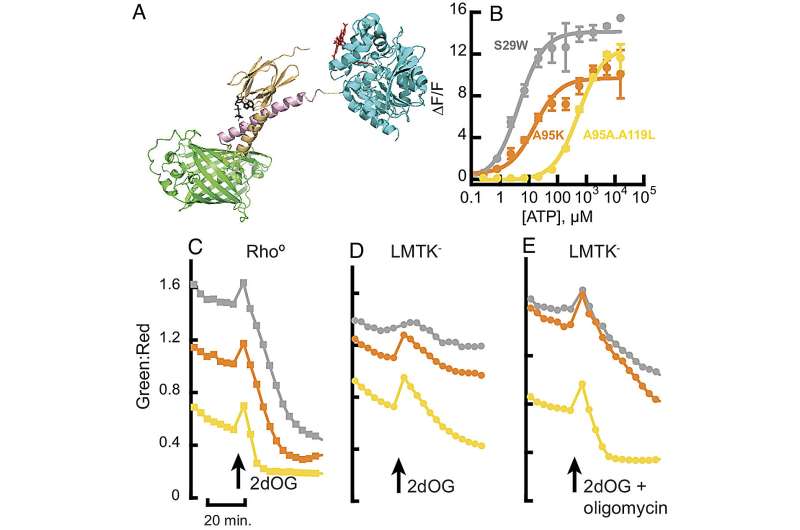This article has been reviewed according to Science X's editorial process and policies. Editors have highlighted the following attributes while ensuring the content's credibility:
fact-checked
peer-reviewed publication
trusted source
proofread
New sensor gives unprecedented look at changes in ATP levels inside a cell

Just as the US economy runs on the dollar, the cellular economy runs on adenosine triphosphate (ATP). The energy-carrying molecule fuels nearly all processes inside the cell, making ATP critical for cellular life.
Now, a new sensor developed at Janelia is giving researchers the best look yet at ATP levels inside living cells, enabling scientists to study in greater detail than ever before how fluctuations in this cellular currency affect the cell and contribute to disease.
Although ATP is critically important to cells, there haven't been good ways for scientists to track how it changes in living cells. Previous ATP sensors were dim, slow, or difficult to use.
In 2019, Janelia and UCLA researchers developed a fluorescent protein sensor, iATPSnFR, that works in a similar way to the popular GCaMP sensors used to detect calcium. A fluorescent molecule is attached to a protein that binds ATP. When this binding occurs, the protein changes shape, causing the fluorescent molecule to light up. This first-generation sensor could detect changes in ATP, but it only operated in a narrow range, so it was not useful for tracking changes in ATP concentrations inside cells.
Now, Janelia scientists and collaborators, led by Jonathan Marvin, a senior scientist on Janelia's Tool Translation Team, have developed the next generation sensor, iATPSnFR2, that can track ATP concentrations over a much larger range. This enables scientists to measure ATP inside living cells in much greater detail than ever before.
The findings are published in the journal Proceedings of the National Academy of Sciences.
Tim Ryan, a researcher at Weill Cornell Medicine and a Janelia Scholar, who worked with Marvin and the team to develop and test the new sensor, used iATPSnFR2 to track changes in ATP at individual synapses, the junctions where neurons communicate.
Ryan and his team are studying how changes in ATP activity at synapses could play a role in the development of Parkinson's disease. The new sensor enables them to directly observe these changes and home in on how these fluctuations could be contributing to the disease.
Beyond this research, the team expects the new sensor will be used by other scientists to study a wide range of research questions involving ATP that have been difficult to answer with previous tools.
More information: Jonathan S. Marvin et al, iATPSnFR2: A high-dynamic-range fluorescent sensor for monitoring intracellular ATP, Proceedings of the National Academy of Sciences (2024). DOI: 10.1073/pnas.2314604121
Journal information: Proceedings of the National Academy of Sciences
Provided by Howard Hughes Medical Institute





















